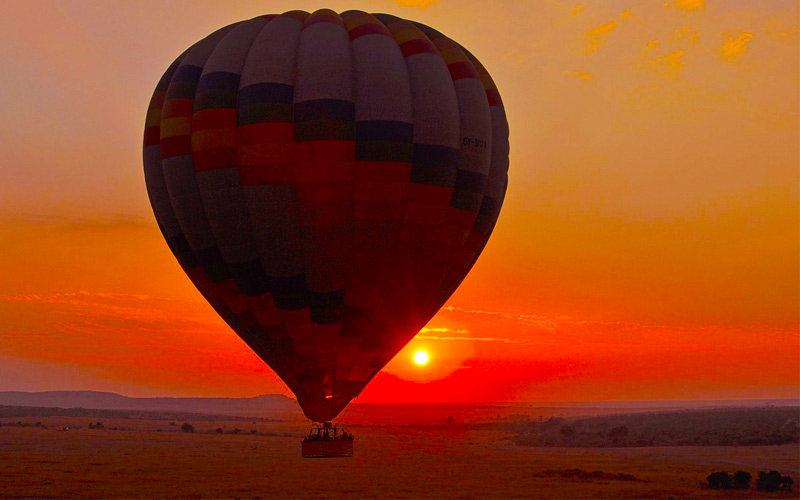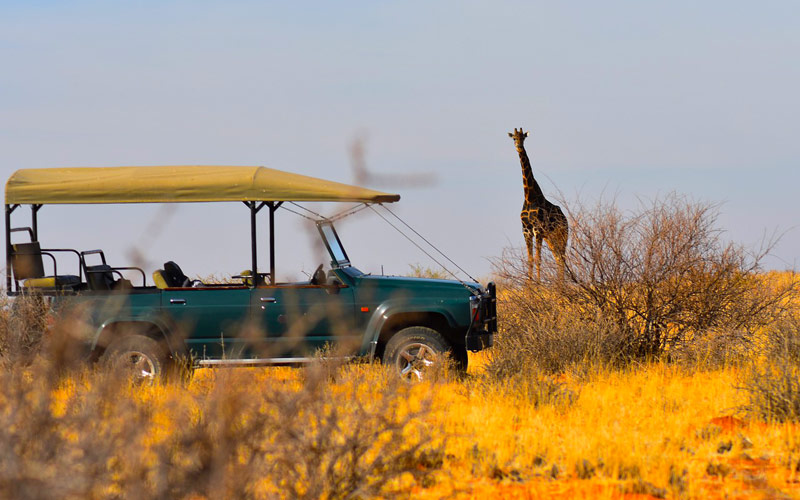Gombe National Park is Tanzania’s smallest park. It’s a 20-mile square (52 km²) patch of rainforest-covered hills on the eastern shores of Lake Tanganyika, well off the beaten safari track.
Visiting Gombe a few months ago and coming face to face with a chimpanzee, my closest animal relative, was a humbling experience.
Getting to Gombe will not be easy or cheap but spending time with these beautiful creatures is an opportunity of a lifetime and well worth the extra effort.
Take a trip to the wild-side in Gombe Stream National Park. Visit the famous Kasekela chimpanzee community, a human-habituated troop from books, documentaries and movies following Dr. Jane Goodall’s research in the park.
In this article, I will share my best insights on how much a Gombe safari costs, the history of Gombe, when is the best time to visit Gombe for viewing chimpanzees, how to get to Gombe, the best budget and luxury accommodation in Gombe, activities you can do in Gombe and other animals you can see in Gombe.
Let's swing in!
My Quick Takeaways:
Thinking of visiting Gombe National Park? Here’s what you need to know at a glance:
- Chimpanzee Encounters: Home to the famous Kasekela chimpanzee community, studied by Dr Jane Goodall.
- Secluded & Special: Tanzania’s smallest national park offers an intimate primate-tracking experience.
- Breathtaking Landscapes: Lush rainforest-covered hills stretch along the shores of Lake Tanganyika.
- Best Time to Visit: May to October is ideal for chimp tracking, with clearer trails and drier conditions.
- Getting There: Accessible by boat from Kigoma, adding to the adventure.
For a full breakdown, let's check out the my article.
Gombe Stream National Park FAQ
Before we get into the Gombe Stream National Park FAQs, it would be a good idea to first orient yourself with the user-friendly map of Tanzania below.
Unlike the popular Northern Circuit national parks (Tarangire, Serengeti, Ngorongoro, Lake Manyara and Arusha), Gombe is located along the western borders of Tanzania and Burundi.
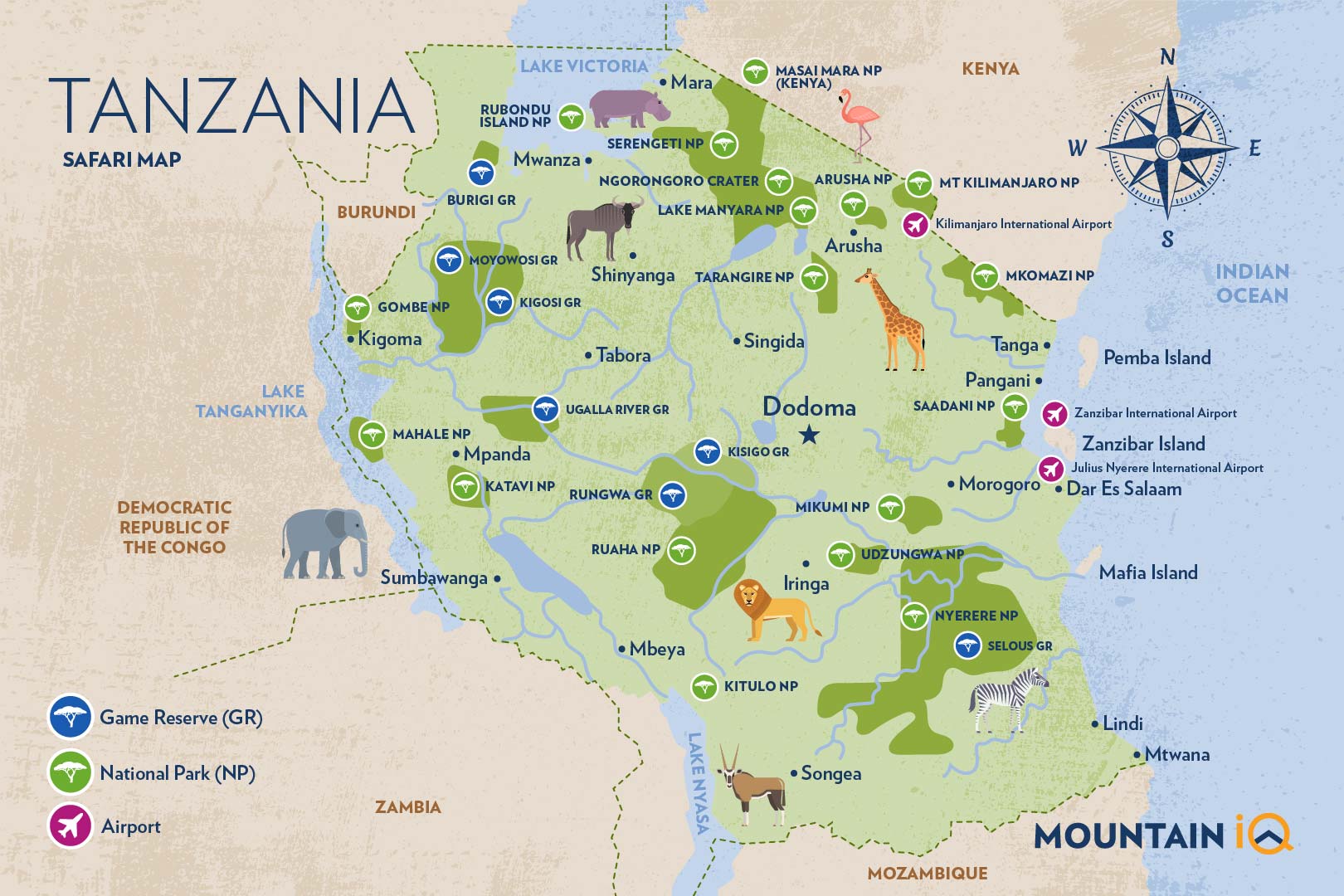
Gombe Stream National Park is just 32 kilometres (about 20 miles) from the lake city of Kigoma.
How much does a Gombe Stream National Park safari cost?
A Gombe safari costs roughly $900 per person per day (including a $100 entrance fee), and also taking into account extra expenses like transportation, accommodation, activities and meals.
Which tour? Here are 3 Gombe safari day tours I recommend:
- Gombe Safari (2 days)
- Moshi Safari that includes Gombe and Kigoma (3 days)
- Chimpanzee Tracking Safari (4 days)
Gombe Stream National Park is only 52 km² (roughly 20 square miles), so most tourists tend to spend 1-2 days there before visiting some of the other notable parks further north.
You can check out more info about prices of Tanzanian safaris and the best Tanzania safari companies.
Also see my other guide to safaris in Tanzania.
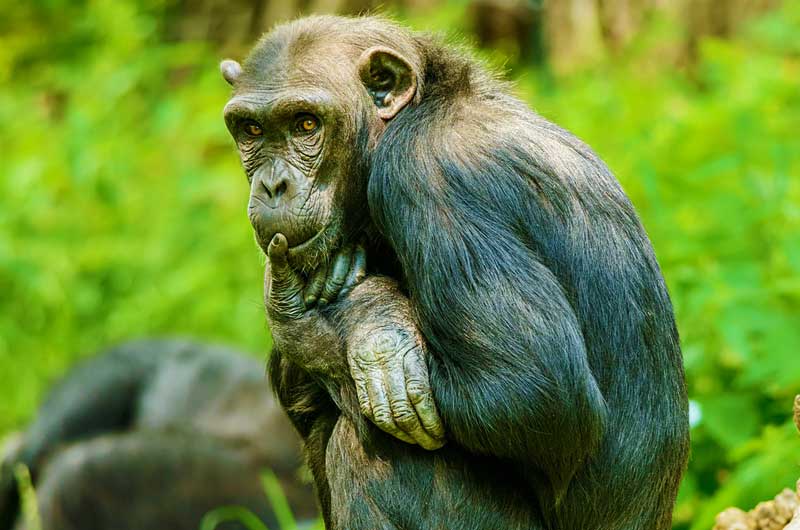
Why is Gombe Stream National Park so famous?
Gombe Stream National Park is so famous because of its rich chimpanzee population and groundbreaking research done by Dame Jane Goodall on the genetic links between chimpanzees and humans.
In 1960, when not much was known about chimpanzee behaviour other than they were similar genetically to humans, Jane Goodall first arrived in what was then Gombe Stream Game Reserve.
She was 26 with no academic background and with only her mother, a cook and his family for assistance.
Goodall’s research was funded by Dr Louise Leakey, a now renowned archaeologist and anthropologist who believed that research into chimpanzee behaviour would help us better understand our early human ancestors.
Goodall spent months tracking chimpanzees, in particular the Kasekela community, and she was eventually accepted into the troop.
This is the only time in history that a group of chimpanzees has accepted a human as one of their own.
With the chimpanzees completely relaxed with her company, Goodall had the opportunity to study chimpanzee behaviour as no one had before.
Goodall’s findings resulted in improvement in conservation of the chimpanzees and their habitats which led to the establishment of the Gombe Stream National Park in 1968.
Which tour? Here are 3 Gombe safari day tours I recommend:
- Gombe Safari (2 days)
- Moshi Safari that includes Gombe and Kigoma (3 days)
- Chimpanzee Tracking Safari (4 days)
Chimpanzee Behaviour
Chimpanzees share numerous similarities (98% of their genes) with us. They live for over 50 years and show a range of emotions, including sorrow and joy.
They are often seen tickling, hugging and even kissing each other as a sign of affection! Can you believe that?
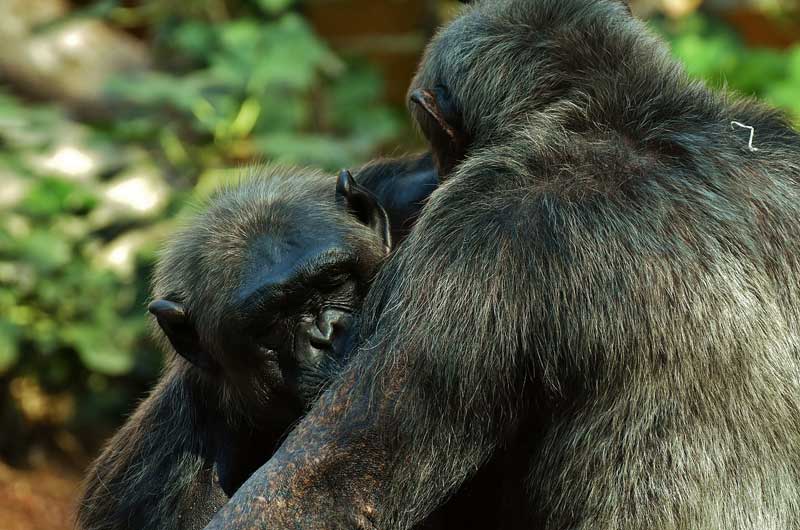
Up until Goodall’s research, it was accepted that only humans could use tools. But she observed a chimp using a grass stalk to extract termites from a termite mound.
Jane Goodall also revealed a darker side to chimpanzee behaviour. She documented females occasionally killing other’s young in an act of dominance, and that there are ongoing, violent wars between different chimpanzee groups.
What Do Chimps Eat?
Like us, chimpanzees are omnivores and not peaceful vegetarians. While spending hours amongst the group, Goodall witnessed the chimpanzees actively and strategically hunting and eating red colobus monkeys.
Chimpanzees hunt and kill a third of Gombe National Park’s red colobus monkey population each year.
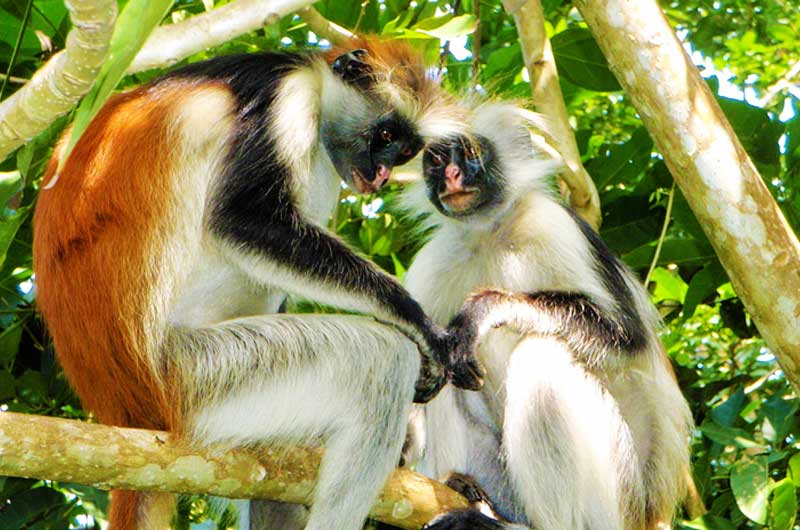
Gombe Stream Research Centre
To coordinate research of chimpanzee behaviour, Gombe Stream Research Centre was established in 1965. The project started by Goodall in 1960 has been ongoing for 60 years making it the longest-running field study of any animal species.
The centre also trains new Tanzanian scientists, hosts visiting researchers and specialists and provides insight into threats like habitat loss, poaching and disease.
The information gained from research at the centre supports conservation management.
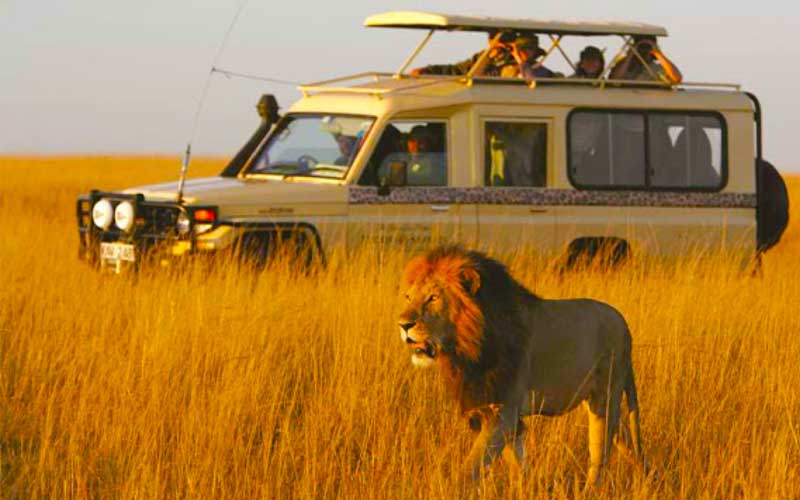
Plan your Safari experience
Check out these amazing deals on epic safari experiences now.
When is the best time to visit Gombe Stream National Park for viewing chimpanzees?
The best time to visit Gombe and view chimpanzees in Gombe Stream National Park is at the end of the dry season (July-October) because they are easier to find when troops remain on lower slopes where there is fruit.
With that said, chimp trekking can essentially be done year-round. If possible, stay at least two full days in Gombe in case you don’t find the chimpanzees on your first day.
My Pro Tip: Read more about the best time to visit Tanzania.
Almost all visitors to Gombe National Park go there for a chance to meet the chimpanzees. There are around 100 chimpanzees remaining in the park.
This includes the Kasekela community who are mostly descendants of the group that Goodall studied. The Kasekala chimps are completely habituated to humans allowing you to get up close and watch their fascinating interactions.
Here are three important tips for tracking chimpanzees:
- start early
- be prepared
- talk to your guide
Start Early
Guides are usually ready to get started as soon as possible to catch the chimps before they move too far up the mountain.
It is better to spend the night in the park before your trek. If you are staying in Kigoma, arrange your private boat transfers for early in the morning.
My Pro Tip: If you take the public boat, you will need to spend 2 nights in the park to work around the limited boat times.
Be Prepared
Chimpanzee trekking is not an easy activity, you will need to have a decent level of fitness for the hike.
Experienced guides track the troop down steep valleys and up the mountains. These are wild animals that do not follow roads or clear pathways so expect to be going through thick bush. Wear long trousers and your hiking boots.
The humid climate makes for a hot and sweaty hike so bring plenty of water (hydration reservoirs that you insert into a backpack are great for that).
There is no guarantee as to how long the trekking will take or if you will find the chimps. Some days are lucky and they are located in half an hour but other days you may walk four hours or longer.
There won’t be time for stopping so best to eat your breakfast before setting off.
Talk to Your Guide
Guides spend hours with these animals, they recognise each individual and have interesting stories to tell. Remember the guides have a challenging job and do not receive high salaries, tipping is customary.
Before your trip to Gombe, don't forget to prepare with a Tanzania safari packing list and bringing the best clothes for an African safari.
Which tour? Here are 3 Gombe safari day tours I recommend:
- Gombe Safari (2 days)
- Moshi Safari that includes Gombe and Kigoma (3 days)
- Chimpanzee Tracking Safari (4 days)
How do I get to Gombe Stream National Park?
There are several ways to get to Gombe Stream National Park. Most tourists begin their journey from Dar Es Salaam to Kigoma, which is a city located next to Lake Tanganyika and 32 kilometres from Gombe.
To get to Kigoma, you can fly commercially from Julius Nyerere International Airport (DAR). There are only 6 of these flights scheduled each week at $150-$220 one way.
Alternatively, driving from Dar Es Salaam to Kigoma will take 22hrs or 18hrs from Arusha. You can also catch a bus or train along the central route.
Public transport will take significantly longer than driving and developing country transport systems often have unforeseen challenges.
From Kigoma, the only way to Gombe is by boat. Again you have a choice when it comes to boats:
- Lake taxi
- Private boat
Lake taxi: This public ferry departs daily at 1 pm from Kibirizi Beach. It is cheap ($5) but uncomfortable. Expect a 4 hour long, crowded trip with multiple stops. Plus, the public boat does not operate on Sundays.
Private boat: These are expensive ($200-$300) but take only 1.5hrs and you can choose your departure time.
Where can I stay in Gombe Stream National Park?
There are lots of places where you can stay while visiting Gombe Stream National Park. Tourists have their pick of budget and luxurious accommodation in and around Kigoma, which is a 40-minute drive from Gombe.
See more on how to choose the best accommodation from budget camping safaris in Tanzania to luxury Tanzania safari lodges.
Where to stay? Here are 5 of my favourite accommodation options close to Gombe Stream National Park:
Budget Rest Houses
Rest houses are more affordable but very basic and sometimes lack care and maintenance. This, however, brings down your entire safari cost a lot.
Don’t expect too much for $20 per person a night. Kasekela Rest House sleeps 12 and has a restaurant that serves local and western dishes, Mitumba Rest House sleeps 5, the park provides a catering or self-catering option.
Luxury Accommodation
Kasekela Luxury Tented Camps ($50- $60 per person) or Jane Goodall Memorial House ($35 per person) are Gombe National Park’s higher-end offers.
Mbali Mbali Lodge (formerly Gombe Forest Lodge) has 7 luxury private tented rooms for a bigger budget. The price of $900 per person per night includes all meals, house drinks and boat transfers.
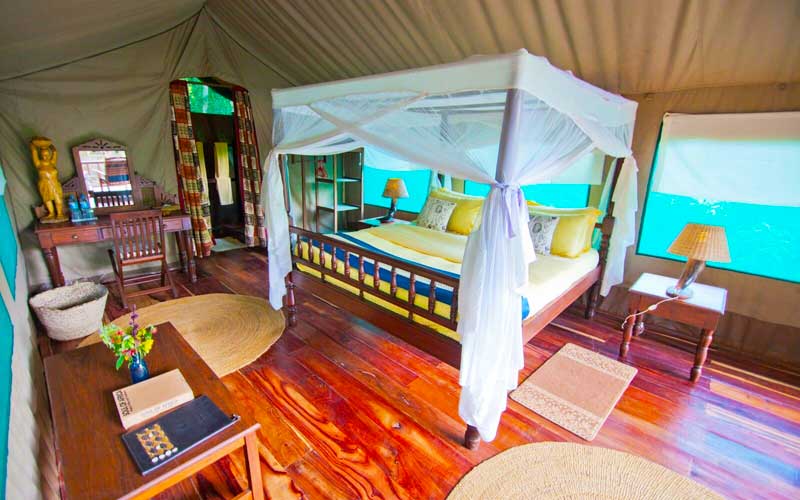
Mbali Mbali Gombe Lodge
What can I do in Gombe Stream National Park?
You can do a lot of things in Gombe Stream National Park. Aside from viewing the chimpanzees, tourists also enjoy engaging in activities involving nature, exercise, and experiencing the local culture.
Swimming and Snorkeling
Lake Tanganyika is the longest and deepest lake in Africa. Calm beaches along the shore of Gombe National Park are perfect for swimming. You can also book a snorkelling tour to see the endemic cichlid fish.
Hiking
Take a gentle walk along the shores of the lake or hike the Kakombe Valley trail to the Waterfall. Hiking is best in the dry season (May-October).
Visit Mwamgongo Village
Located next door to the park, cultural tours around Mwamgongo Village offer a glimpse into the culture of traditional dance and the local woman’s crafting of pottery, fabric, mats, grass hats and baskets.
Other Activities
Catch-and-release fishing trips can be booked with experienced crews and all equipment included. The lake is also perfect for kayaking tours when the weather is calm or to take a traditional dhow cruise to see Tanganyika’s spectacular sunset.
What other animals can I see in Gombe Stream National Park?
Aside from the chimpanzees, there are lots of other animals you can see in Gombe Stream National Park as well.
Animals and Birds
Primates are the main attraction of these rainforests. Besides the chimpanzees, troops of olive baboons walk the beaches foraging for food while vervet monkeys, red-tailed monkeys, blue monkeys and red colobus monkeys climb and leap through the canopy.
Mammals in the forest include bushpigs, bushbuck, duiker, civets and white-tailed mongoose.
There are over 200 bird species in the park. Iconic Fish eagles and three different kingfisher species hunt on the lake and colourful little Peter’s twinspots are regulars at the Visitor Centre. True to name, vegetarian Palm-nut vultures are often seen in palm trees on the lake shores.
The forests are also home to a wide range of amphibians and reptiles like pythons, as well as to 400-500 species of butterflies.
My Final Thoughts
And that's a wrap! I hope you find my best tips useful for visiting Gombe Stream National Park - a place with a rich environmental, cultural and scientific heritage.

